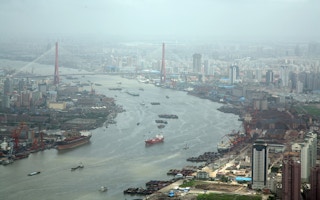With Asia facing a looming water crisis caused by scarcity, pollution and climate change, companies operating in the region could benefit from better disclosure of their water usage and the impact of their commercial activities on water resources, a new survey by CDP suggests.
To continue reading, subscribe to Eco‑Business.
There's something for everyone. We offer a range of subscription plans.
- Access our stories and receive our Insights Weekly newsletter with the free EB Member plan.
- Unlock unlimited access to our content and archive with EB Circle.
- Publish your content with EB Premium.
Water is a crucial component in the success of many businesses and any water-related risks could also threaten their survival, said CDP.
The international not-for-profit group, formerly known as the Carbon Disclosure Project, provides a global system for corporations and cities to measure, disclose, manage and share environmental information.
CDP, which published its first report on water security in China earlier this month (June), noted that while management of water can be a significant driver of innovative and sustainable economic prosperity, its mismanagement can result in significant business failure.
Water insecurity is already presenting the world’s largest industrial water users with serious challenges and they are facing pressure to build long-term resilience to water challenges into their business.
Water stewardship – the responsible, sustainable management of water resources – is one such way of building resilience, Paul Simpson, chief executive officer of CDP, said.
“Corporate water stewardship is emerging as the most effective approach for improving water security,” Simpson said. “Companies engaging in this approach are set to be the winners in an increasingly water insecure world.”
Other benefits of water reporting – the disclosure of business processes and key risks – include stakeholder engagement and winning over shareholders; and a deeper understanding of business risks and opportunities, CDP said.
“The significance of corporate water issues is now being widely recognized by a large and growing number of institutional investors,” CDP said in the report. “These key stakeholders are holding companies accountable for the economic, environmental and social consequences of their water use and management.”
In other words, investors favour businesses that take a pro-active approach to water stewardship.
Under its water programme, CDP works with the market – which includes 617 institutional investors with assets of US$63 trillion - to get companies to disclose their impact on water and take action to reduce them.
Its report on China is the result of a water questionnaire CDP sent in 2014 to 2,200 of the world’s largest publicly quoted companies. Responses were received from 1,064, up 79 percent from 2013.
Lessons from China
Titled “Enhancing water security in China: The business case for corporate water reporting”, the first such report about the water security in the country highlights how mismanagement of water can lead to higher operating costs, and damage to property and a company’s reputation.
CDP found out that companies operating in China, home to 20 percent of the world’s population, are beginning to experience water-related challenges as rapid industrialisation, urbanisation and economic growth put strains on the country’s increasing scarce water resources.
Among the companies that participated are food and drink makers Anheuser Busch InBev, Danone and Nestle; industrial firms Komatsu and Royal Philips; and materials manufacturers AkzoNobel, BASF and Kobe Steel.
While none of the 29 firms with headquarters in China reported having experienced water-related detrimental impact during the period covered by the survey (2013-2014), seven with facilities located in China did.
Forty-three percent of them reported higher operating costs, including one of U.K.’s largest manufacturing and engineering companies, Morgan Advanced Materials, which has seen higher costs, constraints to production and disruption to production schedules due to increased water stress.
A quarter of them reported water-related property damage, such as French construction giant SaintGobain, which said that damage to an industrial facility in Shanghai in the aftermath of the October 2013 typhoon, cost the company five million euros over the last five years.
Half of them said that their brands have been damaged by water-related issues. Spanish clothing company Inditex, for example, reported that it has been hurt by Greenpeace’s ‘Detox’ campaign, which aims to expose direct links between global clothing brands, their suppliers and water pollution resulting from chemical discharge around the world.
As one of the world’s fastest-growing economies, China is facing an acute water crisis. Its factories, farms and more than one billion people need more clean water than its water sources can safely provide.
About 60 percent of the country’s groundwater is polluted, the Chinese government has said, and for the economy to expand at the current rate of 7 percent a year, there is an urgent need to address this problem.
The report analyses information from 29 companies with headquarters in China as well as 70 companies that have facilities and/or supply chains exposed to risk there.
The report also presents the case for corporate water reporting and seeks to uncover business opportunities related to water in the country.
Lo Sze Ping, chief executive officer, World Wide Fund for Nature (WWF) China, which worked on the report with CDP, said as international businesses realise the business risks associated with water stress, they will also uncover the economic benefits of water stewardship as well as their role in minimising their environmental in the communities in which they operate.
“Corporate risk related to water is therefore an emerging issue and is likely to become more significant, due to the aforementioned issues, but also because of investor perceptions, public and media awareness,” Lo added.










